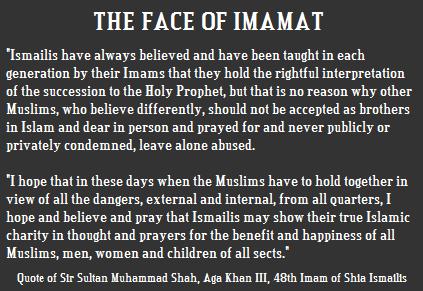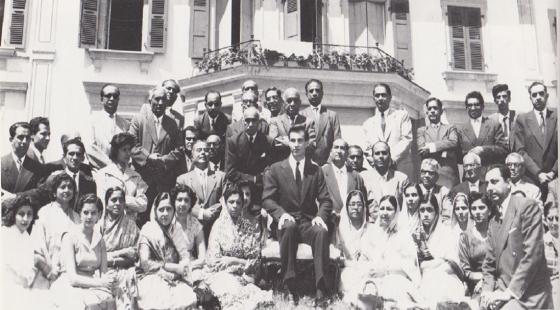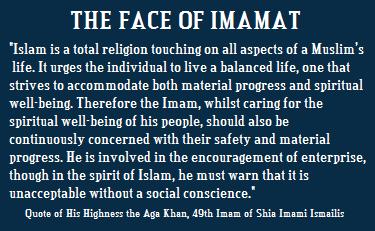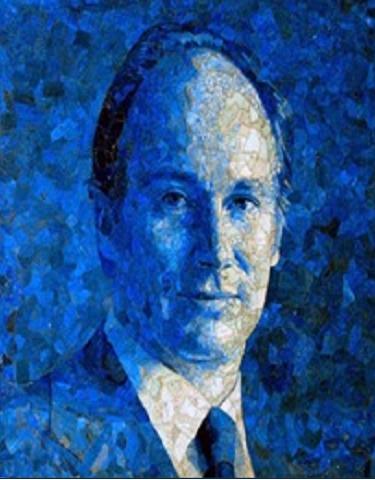

The thoughtful study of the late Aga Khan, 48th Imam of Shia Imami Ismailis, shown above was done in clay by his wife, the Begum Aga Khan, Om Habiba. Image by © Bettmann/CORBIS
In his Platinum Jubilee message, shown in the above quote, Sir Sultan Muhammad Shah, Aga Khan III, had exhorted his Ismaili followers to “show their true Islamic charity in thought and prayers for the benefit and happiness of all Muslims.” The beloved 48th Imam passed away two years later on July 11, 1957, after a reign of seventy two years, but not before giving his followers these and other thoughtful words to live by.
That the late Aga Khan was “a great force working for understanding and harmony between east and west”, as noted by The Times of London, is shown by the following messages of universal appeal that he conveyed:
“All men, rich and poor, must aid one another materially and personally. This fraternity is absolute, and it comprises men of all colours and all races: black, white, yellow, tawny; all are the sons of Adam in the flesh and all carry in them spark of the Divine Light. Everyone should strive his best to see that this spark be not extinguished but rather developed to that full Companionship- on-High.”
To the Ismailis, in addition to the above Platinum Jubilee message, he made the following passionate plea:
“It is my hope that my spiritual children, the Ismailis, will, by example of their own higher enlightenment and co-operative movement amongst themselves set to the world an example of better fraternity and brotherhood which alone can free men from the fear and dangers of moral and mental discord which leads to disaster for all.”

September 1885: The 7-year-old Aga Khan III at his enthronement ceremony as 48th Imam of the Shia Ismaili Ismaili Muslims in Bombay. He is surrounded by community elders and seated on the oblong wooden throne. Photo: Keystone/Hulton Archive/Getty Images, Copyright
The Aga Khan’s death was mourned by people of all communities around the world. For his followers the loss of their long reigning Imam became an occasion to reflect about their traditional and historical understanding and belief about the Institution that he had led – the Imamat. During this mourning and trying period the famous tradition (Hadith) of the Prophet Muhammad:
“I am leaving behind me two things: the Book and my Progeny. If you hold fast to them, you will never go astray,”
and the Quranic verses (3:33-34):
“Verily, God did choose Adam and Noah, the progeny of Abraham, and the progeny of Imran above all the worlds, descendants, one from the other: And God heareth and knoweth all things.”
became comforting factors as Ismailis globally awaited the announcement of who had been designated to continue the hereditary Imamat.
The will of their beloved Imam was then read in front of the Imam’s family at Villa Barakat proclaiming the successor. It said:
Ever since the time of my first ancestor Ali, the first Imam, that is to say over a period of thirteen hundred years it has always been the tradition of our family that each Imam chooses his successor at his absolute and unfettered discretion from amongst any of his descendants whether they be sons or remoter male issue.
In view of the fundamentally altered conditions in the world in very recent years due to the great changes which have taken place including the discoveries of atomic science I am convinced that it is in the best interests of the Shia Moslem Ismailian Community that I should be succeeded by a young man who has been brought up and developed during recent years and in the midst of the new age and who brings a new outlook on life to his office as Imam.
I appoint my grandson Karim, the son of my son Aly Salomone Khan to succeed to the title of Aga Khan and to be the Imam and Pir of all my Shia Ismailian followers.

July 12, 1957: The newly enthroned 49th Imam, Shah Karim al-Hussaini, surrounded by Ismaili leaders and their spouses at Villa Barakat. (See feedback below for individuals who have been identified in this historical photo – ed.)
Through the special designation (or the Nass) of the late Imam, Shah Karim al-Hussaini became the 49th hereditary Imam of the Nizari Ismailis at the age of twenty.
Shortly after, the newly enthroned Imam met Ismaili leaders and representatives from around the world, and also made the following statement:
My grandfather dedicated his life to the Imamat and Islam, both of which came first, and above all other considerations. While I was prepared that one day I might be designated the Aga Khan I did not expect it so soon. I follow a great man in a great responsibility and he could have given me no more appreciated honour than to bequeath me this spiritual leadership. My life, as his, will be dedicated to the service of my followers.
During the course of 2010, Simerg looks forward to publishing a series of articles about the monumental achievements of Shah Karim al-Hussaini, Aga Khan IV.

Shown above is a mosaic portrait in lapis-lazuli of His Highness the Aga Khan, made by the late Pakistani Ismaili artist, Gulgee. Photo Source: Ismailimail.wordpress.com
Dated posted: November-December 2009.
Last updated: January 2, 2017 (caption update – see feedback below)
______________
Notes:
To submit comment or read feedback, scroll to bottom of page.
1. Links to articles in the Aga Khan III series are provided below. Please also see What’s New page for all articles posted on this website (by date). Or go to Home page.
2. All photos shown above which are noted as copyright are published on this website under a licensing agreement with the copyright owners, Getty Images and Corbis. Please do not reproduce these photos without obtaining permission from these photo libraries.
3. The lapis-lazuli mosaic of His Highness the Aga Khan has been enlarged from a smaller version available at Ismailimail.wordpress.com. A brief – but interesting – note about the method the late Gulgee used to produce the mosaic is provided at the bottom of this page.
_____________
Preview Films of the Enthronement:
Please watch the following preview films on Prince Karim Aga Khan’s enthronement in Geneva:
1. New Aga Khan starts reign; Geneva, Switzerland.
Crowds of people outside the late Aga Khan’s villa in Geneva. The new Aga Khan, Prince Karim, walking towards house followed by his father Prince Aly Khan, they are greeted by Aly Khan’s younger brother Prince Sadruddin and his fiancee Nina Dyer. Press photographers surrounding Prince Karim. Prince Karim seated amongst followers.
http://www.britishpathe.com/record.php?id=66782
2. Aga Khan’s Grandson Karim Becomes New Aga Khan IV; Geneva, Switzerland.
People waiting outside the villa Barakat where the leader of Ismail Moslems, Aga Khan lies dead. Lake, pan to general view of the villa. Pan along villa to show the window where the Aga Khan lies. Ali Khan greeting his brother Sadruddin, youngest son of the late Aga Khan. Pan as a man carries a wreath into the villa. Villa. Aga Khan’s grandson Prince Karim, son of Aly Khan, being photographed in a group. Photographers round the group. Prince Karim, new Aga Khan IV, and group of people posing. People waiting outside gates. Pan up to the villa.
http://www.britishpathe.com/record.php?id=34474
_________________
For a complete list of articles in the Aga Khan III series please click: Special Series: His Highness the Aga Khan III
Sources of Aga Khan III and Aga Khan IV quotes:
1. Message to the World of Islam by Aga Khan III, Karachi, 1977.
2. Aga Khan III Selected Speeches and Writings of Sir Sultan Muhammad Shah, Edited by K.K.Aziz, Kegan Paul International, 1997.
(Simerg highly recommends this boxed two volume hard-cover set comprising of over 1500 pages. K.K. Aziz dedicated many years of his life to the study of the 48th Ismaili Imam).
3. Key Note Speech by His Highness the Aga Khan at the Enabling Environment Conference held in Nairobi, Kenya, October 6-7, 1982.
________________
A Brief Note on the Late Gulgee’s Lapis-Lazuli Mosaic of Aga Khan IV
The mosaic portrait of the current Ismaili Imam, Aga Khan IV, shown on this page is made from lapis-lazuli (or lapis), a semi precious stone which has been mined in the Badakhshan province in Central Asia and Afghanistan for thousands of years. The finest lapis has an intense blue colour, and is found in the Kokcha river valley of Badakhshan. Here is a comment made by Crimson East on his blog about how Gulgee carved his mosaics using lapis:
“…I’ve said before that I know little of visual art. But I found his work on lapis lazuli portraits to be nothing short of phenomenal. Take, for instance, this portrait of the Aga Khan (spiritual leader of the Ismaili Muslims – the sect to which Gulgee belonged).
He made many portraits of this kind. The medium used in these mosaics is blue lapis lazuli stones. Basically, Gulgee had to pick through thousands of pieces of blue stone, in varying colors and shapes and sizes. Then he had to arrange them in such a way that they formed a perfect portrait of a living person. He described it as being similar to a giant jigsaw puzzle. I cannot imagine a more fascinating artistic medium…”
Gulgee also did one of the late Imam, Aga Khan III. Click Literary Reading: Sir Sultan Muhammad Shah, Aga Khan III – Defender of Islam, Activist for Justice and Equality, Confidence Booster, And Deliverer of Joy


I can name and pin point some members in this famous photo. Immediately behind Mawlana Hazar Imam is my grand father Count Hassan Kassim-Lakha. To his right is Sir Eboo Pirbhai and to Sir Eboo’s right, sitting down is Vazier Ebrahim Nathoo of Nairobi and to his right, smiling and kneeling is Count Abdallah Hasham Gangji. Behind Ebrahim Nathoo and in dark suit and glasses is Ahmedali Mohamed of Nairobi. To his far right in glasses and light suit is “Janu” Janmohamed of Nairobi. To the left of Hazar Imam sitting down are Nurubai Tejpar of Nairobi (Gulzar Muller’s mother – I can’t recognize Gulzar but she should be there) and next to her left is Countess Hassan Kassim-Lakha and two spots after that is Mrs Ebrahim Nathoo. Fifth gentleman to Mawlana Hazar Imam’s left sitting down is Count Jindhani. Lady Kulsum Eboo Pirbhai is sitting down on the right of Hazar Imam. All the persons in the picture happened to be there at that time. One final note: Count Hassan Kassim-Lakha had the singular honour of presenting Mawlana Shah Karim as our new Imam to all those present and as such to the world wide Jamat.
Update January 8, 2017:
I have two more persons to identify in the above historic picture: The person sitting in the foreground on the bottom right hand side is the past Mukhisaheb of Paris Jamat Khana Mohamed Pirbai (originally of Madagascar) and his wife to his right. The next person I can identify is Count Husseinali Nathoo of Kampala situated behind Count Hassan Kassim-Lakha, to his right shoulder. His wife, Countess Sherbanu Husseinali Nathoo is seated, third from Lady Eboo’s right side. I hope this helps since I have been able to identify 15 out of 44 in the picture. Kind regards, Akber Kassim-Lakha.
Thank you for this article. I am an Ismaili girl from Tajikistan. This information astonished me.
A very wonderful article for everyone – these quote by the Imams are very important for every Murid of the Imam and convey the ethic that the Imams want us to live by. I hope to read your website regularly! May Allah bless us all.
The images of the bust of the late Imam and the Gulgee mosaic are very powerful. Great reading with relevant quotes.